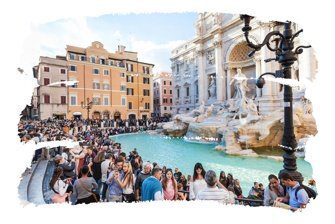What are the types of Italian olive oil?
If there’s one thing Italy knows how to make, it’s olive oil! Italian olive oil is one of the most celebrated in the entire world and is indeed a very special product. Today I bring you a very special post that will surely make your mouth water! Today we will learn: What are the types of Italian olive oil? Here at Your Travel to Italy with Ana Patricia you make the trip of your dreams !!! ALSO: see our “Accommodation in Italy – Tips for your holidays!”
Our introduction
Anyone who cooks knows that a good olive oil can change the entire flavor of that special recipe, and if there’s something that Italians value, they do well, and LOVE it, it’s olive oil! Today we will dive into the world of Italian olive oil and discover why we have a top quality, tasty and unique product! Soare you ready to know what are the types of Italian olive oil?
What is the origin of olive oil?
The origins of olive oil are lost in the mists of time, of course! However, the first evidence of the use of olive oil dates from 4000 BC, in the area of Armenia and Palestine. At that time olive oil was used as an ointment to moisturize the skin; it was also used to power lamps, and used as a medicine, oil was not yet used as food in the way we know it today.
What is olive oil?
Olive oil is the juice obtained by pressing the fruit of the olive tree – scientifically called Olea europaea – by mechanical processes – the pressure of the olive – or other physical processes such as washing, decanting, centrifuging and filtration, under controlled thermal conditions.
Olive oil is a natural product and is one of the symbols of the famous Mediterranean diet. Europe, in order to protect its superior quality, determines that each batch of olive oil produced and marketed on the continent must comply with strict parameters established by the Community.
Regulation 2568/91
The parameters, determined by Regulation 2568/91 (and its subsequent amendments), are part of the commercial classification of oils. These determinations, which must be printed on the label, guide consumers and attest to the origin of the product.
How is olive oil classified according to European regulations?
The European Union classifies olive oil based on three basic elements: the type of extraction with which the oil was obtained, its composition – including the percentage of free acidity (a parameter measured by chemical analysis), and an organoleptic analysis, that is, the properties perceived by our senses: smell, sight, taste and touch; then the oil’s color, shine, transparency, texture, odor and, of course, its flavor are analyzed. So we have the following classification:
1) Virgin Olive Oil
It can be: extra virgin olive oil, virgin olive oil or Lampante oil.
The purest olive oil. That’s because to enter this category, the oil cannot have undergone any alteration that has not been washing, decanting, centrifuging and filtration. They are also considered “virgin” according to their free acidity, which is the value expressed as a percentage of oleic acid, that is, the type of fatty acid predominant in olive oil.
The increase in free acidity also determines a series of modifications that lead to the formation of components, causing an aggravation of the organoleptic characteristics of the oil. In short: the less acidic an oil is, the higher it will rank.
Parameters for Olive Oil Classification
In the classification of extra virgin olive oils, the perfect parameters are:
Extra virgin olive oil
It has superior organoleptic characteristics, is free from defects, has free acidity, expressing its oleic acid that does not exceed 0.8 grams per 100 g (≤ 0.8%).
Virgin olive oil
It is characterized by a free acidity, expressed as oleic acid, which does not exceed 2 grams per 100 g (≤ 2%).
Lampante olive oil
Characterized by small organoleptic defects with a high free acidity that can exceed 2 grams per 100 g (> 2.0%).
FUN FACT
Lampante oil got its name, because in the old days this was the oil used to light lamps! Despite its ancient function, this is a product that has several natural components that are very good for our health, such as essential acids, vitamins, and antioxidant agents.
2) Refined Olive Oil
This oil is obtained from the refining of virgin olive oil. The oil undergoes an industrial process that reduces its acidity and is able to eliminate oxidized substances. Its free acid content, expressed as oleic acid, does not exceed 0.3 grams per 100 g. After being refined, it does not present a drastic change in flavor, however, to be packaged, it must be “balanced”, that is: mixed with virgin or extra virgin olive oil.
3) Olive oil made from virgin olive oils
This type of oil is made up of a mixture of refined and virgin oils. It has a free acidity content, expressed as oleic acid, of not more than 1 gram per 100 g. There is no regulation that determines the minimum percentage of virgin or extra virgin olive oil to be combined with refined; producers normally use 30% refined olive oil and this makes this oil taste very pleasant and nutritionally impeccable.
4) Crude pomace oil
This is an oil extracted from olive pomace and is obtained from the solid residues of the pressing of the fruits. This includes skin, pulp and pits, called bagasse, which, even after pressing, still have a “remain” of oil. It is extracted with a solvent and the same technology applied to the production of seed oils; after the process, the solvent is separated from the oil by distillation.
5) Refined pomace oil
This is an oil obtained from the refining process of crude pomace oil, which has reduced acidity and eliminated oxidized substances.
6) Olive pomace oil
And finally, we have olive pomace oil, which is, in fact, an oil obtained from the mixture of two other oils: refined pomace oil with virgin olive oil.
GOOD TO KNOW
The name EVO is nothing more than the acronym in English for Extra Virgin Oil, that is, extra virgin olive oil.
How is olive oil tasted?
The first step is to put some oil in a glass beaker, covering it with one hand, while turning it while holding the beaker with the other. This serves to slightly heat the oil and thus make it release all its aromas. It is essential to cover the glass to prevent the aromatic notes from dispersing in the air.
After heating the oil, it is necessary to smell the oil
It is necessary to alternate short inhalations with others that are deeper to get the most out of the aroma that the oil gives off. The perfect aroma must be balanced and pleasant.
After this process, the tasting begins!
The oil is placed close to the lips, sucking in the air gently, and then more vigorously, to vaporize it in the mouth; then just put a little of the oil in the mouth, making it come into contact with the taste buds and, via the retro nasal route, with the olfactory bulb.
To feel the residual flavor of the oil and perceive its consistency and fluidity, hold the oil in your mouth for a few seconds, while slowly moving your tongue against your palate, breathing in the air again, always with your lips slightly open.
This phase ends with the expulsion of the oil from the mouth!
No! We do not ingest the product! When you take the oil out of your mouth, you should move your tongue to notice the retro-olfactory sensations that linger in your mouth. Of course, the ritual above is a professional tasting, for those who are professional, my suggestion to know if the oil is good is to put it on the bread! Tasty? Did you like it? So it’s great! LOL!
GOLDEN TIP
In a tasting, the ideal is to taste no more than four samples of olive oil; between one and the other, to cleanse the palate and avoid overlapping flavors, you should drink a little sparkling water or eat a slice of apple.
What are the biggest olive oil producing regions in Italy?
As with wine, all regions produce their own oils, however, some are worth mentioning, such as Sardinia, Calabria, Sicily, Campania, and the successful consortium between Veneto, Lombardy and Trentino, which demystified the fact that only the south Italian knows how to offer good olive oil!
MASTER TIP: do the olive oil tourism in Italy!
Olive oil is so important to Italy that there is a website entirely dedicated to olive oil tourism! No, you didn’t read it wrong: there is olive oil tourism on Italian territory! On this site you have access to events related to olive oil that take place all over Italy, as well as a lot of information about the product! To learn more, CLICK HERE!
Want to do an olive oil tasting and are you in Puglia?
We have the PERFECT tour for you! Find out all the details and make your reservation CLICKING HERE!
How to consume olive oil?
Good quality extra virgin olive oil is excellent on a single slice of toasted bread, for example! It was born to be used raw, in all its simplicity, and can be used in several recipes.
A classic example of its use in traditional recipes is the use of olive oil in Pesto.
The recipe is very simple and uses only olive oil, fresh basil leaves, garlic, pine nuts, parmesan, pecorino cheese and a pinch of coarse salt: and it’s a spectacle! Another classic recipe based on olive oil is the garlic and oil pasta, which in Italy is “aglio e olio”: olio, in Italian, means olive oil!
Olive oil can be used to finish soups too, as well as risottos, and meats:
A touch of the product at the time of serving and you will have a very special flavor on your plate! You can also use olive oil to add flavor to salads, of course!
How about combining with cheeses?
And you can also taste it with cheeses, for example, sheep’s milk cheeses like pecorino, or other aged and semi-aged cheeses.
Did you know that we can even use olive oil in desserts?
Some baked desserts can be prepared with good olive oil, this gives the sweet a very special and velvety taste. You can also replace the butter when making a pie dough, for example: the candy gains a unique flavor!
And now a common question that doesn’t want to be silent: can olive oil be heated?
IT CAN! It’s a myth when they say ‘no’, but some care is necessary, such as being aware of the oil’s smoke point, that is, the temperature to which you are going to submit your oil. That’s because if you heat it too much, you can oxidize the product and degrade it, causing it to release toxic (but harmless) substances like acrolein.
What are the best Italian olive oils?
The oils sold by small artisan shops are usually unbeatable! The big problem is that it is not always easy to find them, but there is good news for olive oil lovers: those found in supermarkets are generally excellent, and, therefore, I bring you a short list of 10 labels with some of the best olive oils to guide you when buying the product in Italian supermarkets.
- Monini Bios – 8,34 euro
- Clemente – 9,32 euro
- Carapelli Bio – 8,14 euro
- Podere del Conte (Rede Eurospin) – 4,79 euro
- Carapelli il Frantoio – 5,41 euro
- DeSantis 100% italiano – 6,13 euro
- DeSantis Classico – 4,43 euro
- Conad Verso Natura Bio – 5,73 euro
- De Cecco Classico – 5,64 euro
- Carapelli Oro Verde – 8,90 euro
Where to buy?
There’s not much of a secret: in the best Italian supermarkets in all Italian cities, even in the smallest towns! By the way, take note of the tip: be sure to pay attention to supermarkets’ own brands, as many of them hire large companies to produce their oils and only change the label, that is: the quality is indisputable!
Watch this video and learn important info about Italy!
Subscribe to our channel and receive more video tips about Italy. Don’t forget to give this video a thumbs-up! 😉
TRAVEL TO ROME!

“Your Travel to Rome” is the quintessential e-book for your travel to one of the finest tourist destinations on the planet!
LEARN MORE
Conclusion
What are the types of Italian olive oil? When we talk about olive oil, it is impossible not to remember the precious Italian oils! Tasty, the oils produced in Italy are very special!
Do you feel unsafe traveling?
If you need help organizing your trip, do not hesitate to contact me! I would love to help you make your dream trip to Italy.
Still in doubt? Be sure to post your questions below, or just send me a message and I will answer you as soon as possible!
An Extra Help for your Trip
The best content from Your Travel to Italy!
Learn more about our tours in Italy right now!
- What to visit in Italy in 10 days?
- The ten must-see places in Tuscany?
- The best tips to save on your trip to Italy?
- What are the 10 most visited cities in southern Italy?
- Airports in Italy? How to get to your hotel? (Venice, Milan, Rome, Florence)
- What to do in 1/2/3/4 days in the main Italian cities?
- The best tips on food in Italy (wines, typical food, enogastronomy tours)
- How to get from Fiumicino Airport to Rome downtown?
- Your Travel to Italy: 10 tips for traveling through Italy!
Best regards from Italy

 PLACES TO STAY IN ITALY
PLACES TO STAY IN ITALY


 Save money!
Save money!